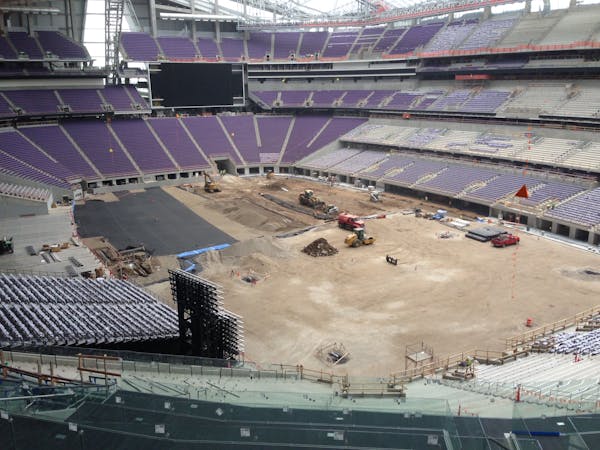When Lester Bagley started lobbying efforts 15 years ago to help the Vikings get a new stadium, he couldn't have imagined some of the details involving fan experience that would evolve between then and now — a mere six months from the opening of U.S. Bank Stadium.
Bagley, the Vikings' executive vice president of stadium development and public affairs, noted one of the major changes during a Tuesday tour of the 90-percent-complete stadium: a specialty area called Club Purple.
In one sense, Club Purple is a premium seating area and not unlike the types of upgrades that have fueled new stadium construction for many years. The difference is the kind of experience the Vikings are trying to provide with this specific club.
"It has different seating — more couch or lounge seating to watch the game," Bagley said. "But if you go up behind the seating, there's a lounge and bar with TVs and a ticker where you'll be able to follow your fantasy football team."
In short, it aims to bring the experience of watching a game at home into the stadium — which seems backward until you understand the psyche of the modern fan.
"We've gotten a lot of feedback from folks and fans who care about fantasy football. It's all about the fan experience. We have to get people off their couches and get them into the stadium," Bagley said. "Now they can still have a couch and watch the game while still being plugged into their [fantasy] team. We're trying to keep them engaged and give them the fan experience that's paramount."
Bagley said Club Purple patrons will be able to enter the club to watch the early NFL games if the Vikings have a late kickoff. The Vikings also plan on bringing in fantasy football experts to give fans lineup advice on which players to start and which ones to sit.
"Over the last few years, as fantasy football has become dominant on game day, we've tried to roll with that and listen to the experts," Bagley said. "We think we'll have a pretty good solution."
Fans in regular seating will have to keep up with their fantasy teams the old-fashioned way: by obsessively checking their smartphones between plays.
OK, that's not old-fashioned at all. It's just what modern consumers expect. And to that end, Bagley pointed to nearby handrails and noted the stadium Wi-Fi is located within them — along with a distributed antenna system throughout the building.
"It's designed so 66,000 people can all get on their phones at the same time — both the Internet and otherwise," Bagley said. "Connectivity is extremely important as we go forward. That's part of the fan experience."

Anderson: Building a new Waterville fish hatchery will help shorten the time between bites
Seth Lugo throws 7 scoreless innings, leads Royals past Tigers 8-0
Star driver Josef Newgarden fights back tears, accepts blame for breaking rules in IndyCar scandal
Oregon State and Washington State face player exodus amid realignment

